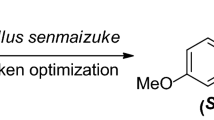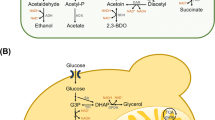Abstract
The bioreduction of prochiral ketones offers efficient access to chiral secondary alcohols, which are potentially beneficial precursors for producing many biologically active compounds and natural products. This bioreduction process can be affected by different parameters when whole-cell of biocatalysts such as Lactic Acid Bacteria strains are applied. In this context, this paper proposed an I-optimal design-based model to optimize culture parameters such as temperature, pH, incubation period, and agitation speed for asymmetric bioreduction of 2-methyl-1-phenylpropan-1-one (1) with Lactobacillus fermentum BY35 as a biocatalyst while achieving the highest conversion rate (cr) and enantiomeric excess (ee). The optimum settings of the four culture parameters and the cr and ee values were found using the proposed optimization model as follows: pH = 6.5, temperature = 25 °C, incubation period = 38.5 h, agitation speed = 200 rpm, the ee value = 98.78%, and the cr value = 98.92%. After the validation of the process, the cr and ee values were found to be > 99% and > 99%, respectively, while using the optimum operating conditions from the optimization model. Thus, the results of the optimization model are consistent with the results of the validation experiment. It is also noted that this paper is the first to optimize culture parameters using the proposed I-optimal design-based model for an asymmetric reduction.



Similar content being viewed by others
References
Ahmed, M.; Kelly, T.; Ghanem, A.: Applications of enzymatic and non-enzymatic methods to access enantiomerically pure compounds using kinetic resolution and racemisation. Tetrahedron 68, 6781–6802 (2012)
Brooks, W.H.; Guida, W.C.; Daniel, K.G.: The significance of chirality in drug design and development. Curr. Top. Med. Chem. 11(7), 760–770 (2011)
Yang, G.F.; Huang, X.: Development of quantitative structure-activity relationships and its application in rational drug design. Curr. Pharm. Des. 12(35), 4601–4611 (2006)
LaPlante, S.R.; Fader, L.D.; Fandrick, K.R.; Fandrick, D.R.; Hucke, O.; Kemper, R.; Edwards, P.J.: Assessing atropisomer axial chirality in drug discovery and development. J. Med. Chem. 54, 7005–7022 (2011)
Galvão, W.S.; Pinheiro, B.B.; Golçalves, L.R.B.; De Mattos, M.C.; Fonseca, T.S.; Regis, T.; Zampieri, D.; Dos Santos, J.C.S.; Costa, L.S.; Correa, M.A., et al.: Novel nanohybrid biocatalyst: Application in the kinetic resolution of secondary alcohols. J. Mater. Sci. 53, 14121–14137 (2018)
Vieira, G.A.; Araujo, D.M.; Lemos, T.L.; Mattos, M.C.D.; Oliveira, M.D.C.F.D.; Melo, V.M.; Gonzalo, G.D.; Gotor-Fernández, V.; Gotor, V.: Candida tropicalis CE017: a new Brazilian enzymatic source for the bioreduction of aromatic prochiral ketones. J. Braz. Chem. Soc. 21, 1509–1516 (2010)
Cen, Y.; Li, D.; Xu, J.; Wu, Q.S.; Wu, Q.; Lin, X.F.: Highly focused library-based engineering of candida antarctica Lipase B with (S)-selectivity towards sec-alcohols. Adv. Synth. Catal. 361, 126–134 (2019)
Noyori, R.; Hashiguchi, S.: Asymmetric transfer hydrogenation catalyzed by chiral ruthenium complexes. Acc. Chem. Res. 30(2), 97–102 (1997)
Corey, E.J.; Helal, C.J.: Reduction of carbonyl compounds with chiral oxazaborolidine catalysts: a new paradigm for enantioselective catalysis and a powerful new synthetic method. Angew. Chem. Int. Ed. 37(15), 1986–2012 (1998)
Lawrence, N.J.; Drew, M.D.; Bushell, S.M.: Polymethylhydrosiloxane: a versatile reducing agent for organic synthesis. J. Chem. Soc., Perkin Trans. 1, 3381–3391 (1999)
Mimoun, H.; de Saint Laumer, J.Y.; Giannini, L.; Scopelliti, R.; Floriani, C.: Enantioselective reduction of ketones by polymethylhydrosiloxane in the presence of chiral zinc catalysts. J. Am. Chem. Soc. 121(26), 6158–6166 (1999)
de Carvalho, C.: Whole cell biocatalysts: essential workers from nature to the industry. Microb. Biotechnol. 10(2), 250–263 (2017)
Verho, R.; Londesborough, J.; Penttilä, M.; Richard, P.: Engineering redox cofactor regeneration for improved pentose fermentation in Saccharomyces cerevisiae. Appl. Environ. Microbiol. 69(10), 5892–5897 (2003)
Lee, W.H.; Kim, M.D.; Jin, Y.S.; Seo, J.H.: Engineering of NADPH regenerators in Escherichia coli for enhanced biotransformation. Appl. Microbiol. Biotechnol. 97(7), 2761–2772 (2013)
Yu, S.; Li, H.; Lu, Y.; Zheng, G.: A catalyst from Burkholderia cenocepacia for efficient anti-Prelog’s bioreduction of 3, 5-bis (trifluoromethyl) acetophenone. Appl. Biochem. Biotechnol. 184(4), 1319–1331 (2018)
Ranjan, P.; Pandey, A.; Binod, P.: Resolution of enantiopure (S)-1-(1-napthyl) ethanol from racemic mixture by a novel Bacillus cereus isolate. J. Basic. Microbiol. 57(9), 762–769 (2017)
Griffin, D.R.; Yang, F.; Carta, G.; Gainer, J.L.: Asymmetric reduction of acetophenone with calcium-alginateentrapped baker’s yeast in organic solvents. Biotechnol. Prog. 14(4), 588–593 (1998)
Comasseto, J.V.; Andrade, L.H.; Omori, A.T.; Assis, L.F.; Porto, A.: Deracemization of aryl ethanols and reduction of acetophenones by whole fungal cells of Aspergillus terreus CCT 4083, Aterreus CCT 3320 and Rhizopus oryzae CCT 4964. J. Mol. Catal. B. Enzym. 29(1–6), 55–61 (2004)
Sato, I.; Saito, T.; Soai, K.: Solvent-free catalytic enantioselective addition of diethylzinc to aldehydes. Chem. Commun. 24, 2471–2472 (2000)
Sato, I.; Shibata, T.; Ohtake, K.; Kodaka, R.; Hirokawa, Y.; Shirai, N.; Soai, K.: Synthesis of chiral dendrimers with a hydrocarbon backbone and application to the catalytic enantioselective addition of dialkylzincs to aldehydes. Tetrahedron Lett. 41(17), 3123–3126 (2000)
Ling, F.; Nian, S.; Chen, J.; Luo, W.; Wang, Z.; Lv, Y.; Zhong, W.: Development of ferrocene-based diamine-phosphine-sulfonamide ligands for iridium-catalyzed asymmetric hydrogenation of ketones. J. Org. Chem. 83(18), 10749–10761 (2018)
Şahin, E.: First green synthesis of (R)-2-methyl-1-phenylpropan-1-ol using whole-cell Lactobacillus paracasei BD101 biotransformation. Biocatal. Biotransfor. 38(2), 138–143 (2020)
Pereira, R.S.: The use of baker’s yeast in the generation of asymmetric centers to produce chiral drugs and others compounds. Crit. Rev. Biotechnol. 18, 25–64 (1998)
Dertli, E.; Mercan, E.; Yılmaz, M.T.; Sagdıc, O.: Characterisation of lactic acid bacteria from Turkish sourdough and determination of their exopolysaccharide (EPS) production characteristics. LWT-Food Sci. Technol. 71, 116–124 (2016)
Yu, J.; Long, J.; Yang, Y.; Wu, W.; Xue, P.; Chung, L.W.; Zhang, X.: Iridium-catalyzed asymmetric hydrogenation of ketones with accessible and modular ferrocene-based amino-phosphine acid (f-ampha) ligands. Org. Lett. 19, 690–693 (2017)
Ozdemir, A.: An I-optimal experimental design-embedded nonlinear lexicographic goal programming model for optimization of controllable design factors. Eng. Optim. 53, 392–407 (2021)
Özdemir, A.: Development of a bi-objective 0–1 mixed-integer nonlinear response surface-based robust design optimization model for unbalanced experimental data. Comput. Ind. Eng. 158, 107446 (2021)
Wanda, K.M.; Agnieszka, M.: Enantio selective reduction of bromo- and methoxy acetophenone derivatives using carrot and celeriac enzymatic system. Tetrahedron Asymm. 15(13), 1965–1967 (2004)
Sahin, E.: Production of (R)-1-(1,3-benzodioxol-5-yl) ethanol in High Enantiomeric Purity by Lactobacillus paracasei BD101. Chirality 30, 189–194 (2018)
Nakamura, K.; Yamanaka, R.; Matsuda, T.; Harada, T.: recent developments in asymmetric reduction of ketones with biocatalysts. Tetrahedron Asymm. 14, 2659–2681 (2003)
Mandal, D.; Ahmad, A.; Khan, M.I.; Kumar, R.: enantioselective bioreduction of acetophenone and its analogous by the fungus trichothecium sp. J. Mol. Catal. B: Enzym. 27, 61–63 (2004)
Yılmaz, D.; Sahin, E.; Dertli, E.: Highly enantioselective production of chiral secondary alcohols using lactobacillus paracasei BD 101 as a new whole cell biocatalyst and evaluation of their antimicrobial effects. Chem. Biodivers. 14, e1700269 (2017)
Myers, R.H.; Montgomery, D.C.; Anderson-Cook, C.M.: Response Surface Methodology: Process and Product Optimization Using Designed Experiments. John Wiley & Sons, Hoboken, New Jersey (2016)
Özdemir, A.; Dertli, E.; Şahin, E.: Optimization of asymmetric reduction conditions of 1-(benzo [d][1, 3] dioxol-5-yl) ethanone by Lactobacillus fermentum P1 using D-optimal experimental design-based model. Prep. Biochem. Biotechnol. (2021). https://doi.org/10.1080/10826068.2021.1925913
Acknowledgements
We want to thank Bayburt University Central Research Laboratory for HPLC analysis.
Author information
Authors and Affiliations
Corresponding author
Rights and permissions
About this article
Cite this article
Aksuoğlu, S., Özdemir, A., Serencam, H. et al. Optimization of Asymmetric Bioreduction Conditions of 2-methyl-1-phenylpropan-1-one by Lactobacillus fermentum BY35 Using I-Optimal Design-Based Model. Arab J Sci Eng 47, 6505–6514 (2022). https://doi.org/10.1007/s13369-021-06434-5
Received:
Accepted:
Published:
Issue Date:
DOI: https://doi.org/10.1007/s13369-021-06434-5




